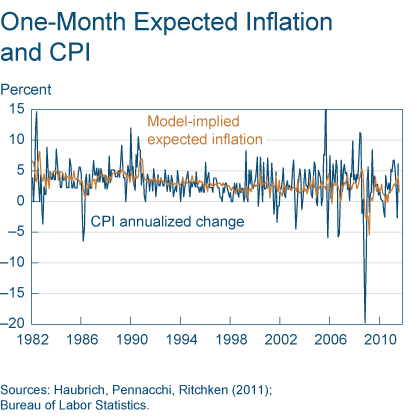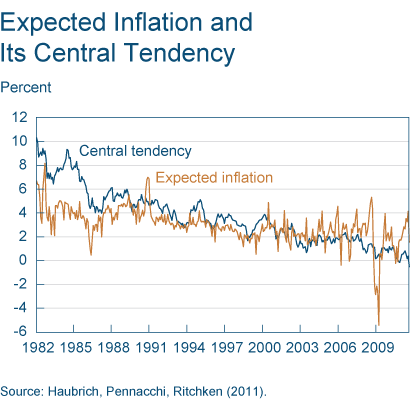- Share
The Future of Inflation
According to consumer price measures like the CPI, inflation has recently jumped up a notch. What those measures don’t tell us is whether the increase will persist. In this Commentary, we look at a measure that does. The measure incorporates data on past inflation rates, surveys of expected inflation, inflation swaps, and a variety of interest rates. It provides estimates of inflation, along with expected inflation and real interest rates. A look at the measure’s estimates suggests that the recent increases in inflation are likely to be temporary.
The views authors express in Economic Commentary are theirs and not necessarily those of the Federal Reserve Bank of Cleveland or the Board of Governors of the Federal Reserve System. The series editor is Tasia Hane. This paper and its data are subject to revision; please visit clevelandfed.org for updates.
According to consumer price measures like the CPI, inflation has recently jumped up a notch. What those measures don’t tell us is whether the increase will persist. In this Commentary, we look at a measure that does. The measure incorporates data on past inflation rates, surveys of expected inflation, inflation swaps, and a variety of interest rates. It provides estimates of inflation, along with expected inflation and real interest rates. A look at the measure’s estimates suggests that the recent increases in inflation are likely to be temporary.
Recently, inflation, as measured by the headline Consumer Price Index, has been running at a sustained clip—prices have risen over 4.5 percent in five of the past seven months, and in July they increased at an annualized rate of 6.2 percent. How worried should we be that the recent numbers represent a sustained increase in inflation? After all, prices can be quite variable, and in fact they fell in June (2.6 percent).
Experts have different opinions about the danger. Often, their opinion depends on which economic theory they adhere to. Some people point to the large amounts of liquidity (and correspondingly high monetary base) provided by the Federal Reserve over the past several years and predict high inflation. Others point to the inverse relationship between inflation and unemployment and predict, if anything, dangerously low inflation.
In this Commentary, we look at what we can learn about the behavior of inflation from the effects it has on financial markets and people’s expectations. Looking at these effects will provide some perspective on the recent price increases from the standpoint of monetary policy. If markets and consumers believe price increases are temporary, the central bank can be less concerned that inflation will be a problem.
Of course, knowing that price increases are temporary doesn’t make filling up your gas tank or grocery cart today any less painful. But for budgeting purposes, it helps to know the pain won’t last long enough to cut into your daughter’s college fund. Just as important, knowing that prices won’t continue to rise can prevent the central bank from fighting an imaginary monster, needlessly tightening policy.
Uncovering Inflation
People probably follow prices more closely than any other kind of economic data. Still, we have no surefire way of telling when a streak of rising prices will get worse or persist. Inflation is by definition a rise in prices in general. Economists use a number of approaches to judge whether the latest data on prices indicate that inflation will persist or not.
One of the more popular approaches looks at “core” inflation. Core inflation measures strip out food and energy prices, or even larger portions of the consumer market basket. This has its justifications, in that dropping the most variable prices can often better reveal the underlying trend. Still, since people buy gas and milk, there is some logic in looking at overall prices, not just a subset. Some economists find fault with core measures for this reason.1
Another drawback of focusing on the core is that most surveys and financial products that are tied to inflation use the headline CPI as the reference point, not the core. These surveys and products can give important clues about the future of inflation.
Surveys and financial products can provide another, albeit indirect, approach to gauging future inflation. Instead of looking backwards at past prices they involve a forecast of inflation. Surveys that ask about people’s inflation expectations are one example. Financial instruments that have payouts which depend on inflation, such as inflation swaps, are another.
We’ve described in several articles one approach we take at the Federal Reserve Bank of Cleveland. This approach uses data on past inflation rates, survey measures of expectated inflation, inflation swaps, and a variety of interest rates. From all this, it backs out measures of inflation, expected inflation, and real interest rates. (See “Inflation: Noise, Risk, and Expectations, A New Approach to Gauging Inflation Expectations,” and for more technical detail, “Inflation Expectations, Real Rates, and Risk Premia: Evidence from Inflation Swaps.”)
This rather complicated procedure has some advantages over the simpler and more common measure of inflation expectations that comes from the financial markets, the breakeven rate. Breakeven rates often overstate inflation expectations because they also include a risk factor. The risk factor slips in because inflation is uncertain. The additional information in the Cleveland Fed’s approach gives a purer measure of expectations.
More importantly for our purposes here, the Cleveland Fed approach also yields a pattern for inflation that can be used to gauge if recent increases are a temporary aberration or the start of a dangerous upward trend. A simple way to state the problem would be to ask if the changes in inflation are permanent or temporary. This is hardly a problem unique to economics: Is a warm spring global warming or just weather? Were Republican electoral victories in 2010 a generational shift or a minor midterm correction? Did the Cleveland Browns’ fast start in 2011 presage a resurgent franchise or just a lucky streak that will leave fans disappointed by playoff time?
The question is not really either/or, however, because a higher inflation rate will often be a mixture of both: some part of the increase in prices will fade away relatively quickly but a bit will hang around for quite a while. In this regard, inflation has two components, a short-term, temporary effect and a long-term, permanent factor. Watching inflation over a long time period would reveal which factor was more important. We would see if inflation stayed high once it started moving higher or if it tended to rapidly drop back to a more normal level. With this experience, you could then make an informed guess about the recent changes and how permanent or transitory they are expected to be.
However, things aren’t always as simple as they seem, and this holds true for inflation. There are in fact different degrees of “transitory”—does the effect disappear right away, or hang around for a few months? And the underlying permanent level of inflation may itself slowly change over time. The Cleveland Fed approach to inflation builds on this underlying pattern (or “process”) but is somewhat more complicated, with more than just two factors. In our model, actual inflation is expected inflation plus a very temporary random shock.
Expected inflation is somewhat less transitory: it is mean reverting. That is, shocks move it up and down, but the expected rate of inflation slowly tends to move back toward a longer-run average, termed the central tendency. That central tendency itself moves around, slowly tending toward the long-run historical mean of inflation in the United States. The path of inflation might then look something like the path of a small airplane, buffeted by winds, gradually returning to its flight path, which is itself moving around.
Figures 1 and 2 show how this pattern plays out. Figure 1 plots monthly actual annualized inflation (that is, what the inflation rate would be if prices rose at that rate for the entire year) and inflation expectations (again, monthly, at an annualized rate). Actual inflation is much more variable than expected inflation.

Sources: Haubrich, Pennacchi, Ritchken (2011); Bureau of Labor Statistics.

Source: Haubrich, Pennacchi, Ritchken (2011).
That constitutes a lesson in itself, delivering a warning to expect the unexpected, and that reality does not always match expectations. How big those surprises are varies over time, however, and one can clearly see the great moderation of the 1990s reflected in the lower variability of inflation. Despite the many ups and downs, however, inflation does seem to vary around the expected level.
Figure 2 again shows the monthly expected inflation, this time pairing it with the central tendency. There are several things to notice. Perhaps the most obvious is that the central tendency of inflation has declined greatly over the past 30 years. In the 1980s it hit above 10 percent. Now, it is well below 2 percent.
Expected inflation shows less of a downward trend, but it too shows a gradual decrease from the great inflation of the 1970s. Monthly expected inflation also generally varies more than the central tendency, particularly in recent years. Expected inflation has moved up recently, but the central tendency has moved down.
The Road Ahead
What do these patterns mean for the future path of inflation? As always, prediction is difficult, particularly about the future. But to the extent that inflation tracks toward expected inflation, and expected inflation tracks toward the central tendency, which tends to move slowly, it is the central tendency that gives the best view of inflation in the medium to longer term. To the extent that actual inflation varies more than expected inflation and expected inflation varies more than the central tendency, there is reason to think that the high rates we have been experiencing are temporary, soon to be replaced with a different cut from the deck.
One way to think about this is the notion of “half-life.” The term originated in physics, where it describes the time it takes for half of a radioactive substance to decay. In the case of inflation, it is the time it takes for half of the effect of the initial price shock to wear off. If inflation temporarily jumps up by 1 percentage point, how long until it is just half a percentage point above the average? Expected inflation drops back quickly, with a half life of only three months. Put another way, one year later, the effects of the shock would be barely noticeable (one half of a half of a half of a half, or a sixteenth.) The central tendency moves much more slowly, returning halfway to its mean only after 12 years.
This is perhaps a long way of saying that the recent high levels of inflation look to be temporary, and that the central tendency provides a better view of where inflation is headed in the medium to long term.
But, as always in economics, there is an “on the other hand.” Actual inflation and expectations revert back toward the central tendency—but in times of major historic shifts, such as the end of the great inflation in the early 1980s, it was the central tendency that slowly came down, as central banks built up credibility by keeping inflation (relatively) low for a while. Furthermore, there is a danger of thinking about inflation as something inexorable, like radioactive decay. Instead, it is the outcome of decisions by actual people, and embeds expectations about what decisions will be made, particularly decisions by the central bank.
With stable prices a mandated goal of the Federal Reserve, understanding how inflation adjusts is a top priority. An examination of the data shows that most of the recent increases are likely to be temporary, and the longer-term component of inflation is much lower than recent price increases suggests.
Footnote
- For example, Bullard (2011). Return
Recommended Reading
- “Inflation: Noise, Risk, and Expectations, A New Approach to Gauging Inflation Expectations,” by Timothy Bianco and Joseph G. Haubrich, 2010. Federal Reserve Bank of Cleveland, Economic Commentary.
- “Inflation Expectations, Real Rates, and Risk Premia: Evidence from Inflation Swaps,” by Joseph G Haubrich, George Pennacchi, and Peter Ritchken, 2011. Federal Reserve Bank of Cleveland, working paper no. 11-07.
- “Measuring Inflation: The Core Is Rotten,” by James Bullard, 2011. Federal Reserve Bank of St. Louis, Review.
Suggested Citation
Haubrich, Joseph G. 2011. “The Future of Inflation.” Federal Reserve Bank of Cleveland, Economic Commentary 2011-20. https://doi.org/10.26509/frbc-ec-201120
This work by Federal Reserve Bank of Cleveland is licensed under Creative Commons Attribution-NonCommercial 4.0 International





